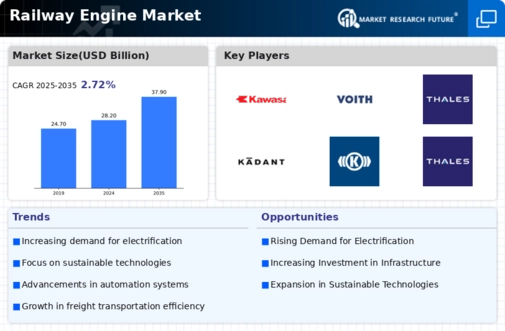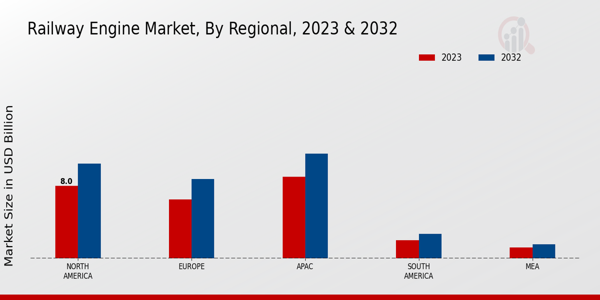Expansion of Freight Rail Services
The expansion of freight rail services is a significant driver for the Railway Engine Market. As global trade continues to grow, the demand for efficient freight transport solutions is increasing. Railways offer a cost-effective and environmentally friendly alternative to road transport, making them an attractive option for logistics companies. Recent statistics indicate that rail freight transport can be up to four times more fuel-efficient than trucking. This efficiency is likely to encourage more businesses to shift their logistics strategies towards rail transport, thereby increasing the demand for advanced railway engines capable of handling larger volumes and heavier loads. As a result, the Railway Engine Market is expected to witness substantial growth, driven by the need for enhanced freight capabilities and operational efficiency.
Government Initiatives and Investments
Government initiatives and investments are pivotal in driving the Railway Engine Market. Many governments are prioritizing rail infrastructure development as part of their transportation policies, recognizing the economic and environmental benefits of rail transport. For example, substantial funding is being allocated to upgrade existing rail networks and develop new lines, which directly impacts the demand for modern railway engines. Recent reports indicate that investments in rail infrastructure could exceed several billion dollars over the next decade. These initiatives not only enhance connectivity but also stimulate job creation and economic growth. As a result, the Railway Engine Market is likely to benefit from increased orders for advanced engines that comply with new regulatory standards and operational requirements.
Growing Focus on Environmental Regulations
The growing focus on environmental regulations significantly influences the Railway Engine Market. As countries implement stricter emissions standards, railway operators are compelled to upgrade their fleets to comply with these regulations. This shift is driving the demand for cleaner and more efficient railway engines, particularly those that utilize alternative fuels or electric power. Data indicates that the transition to low-emission engines could reduce the carbon footprint of rail transport by up to 50 percent. Consequently, manufacturers are investing in the development of engines that not only meet regulatory requirements but also enhance operational efficiency. This trend suggests a robust market for innovative solutions within the Railway Engine Market, as stakeholders seek to align with global sustainability goals.
Technological Advancements in Engine Design
Technological advancements play a crucial role in shaping the Railway Engine Market. Innovations in engine design, such as the integration of lightweight materials and advanced propulsion systems, are enhancing performance and fuel efficiency. For instance, the introduction of hybrid and electric engines is transforming traditional railway operations, offering reduced operational costs and lower emissions. Data suggests that the adoption of these technologies could lead to a 30 percent increase in fuel efficiency over conventional engines. Furthermore, the implementation of predictive maintenance technologies is likely to minimize downtime and improve reliability. As manufacturers continue to invest in research and development, the Railway Engine Market is poised for significant growth, driven by the demand for cutting-edge technology that meets modern transportation needs.
Increasing Demand for Efficient Transportation
The Railway Engine Market experiences a notable surge in demand for efficient transportation solutions. As urbanization accelerates, the need for reliable and cost-effective public transport systems becomes paramount. Railways, being one of the most efficient modes of transport, are increasingly favored for both passenger and freight services. According to recent data, rail transport can reduce greenhouse gas emissions by up to 75 percent compared to road transport. This shift towards railways is likely to drive investments in new railway engines, enhancing operational efficiency and reducing costs. Consequently, manufacturers are focusing on developing advanced railway engines that meet the growing demand for speed, reliability, and environmental sustainability. This trend indicates a robust growth trajectory for the Railway Engine Market, as stakeholders seek to capitalize on the increasing preference for rail transport.






















Leave a Comment